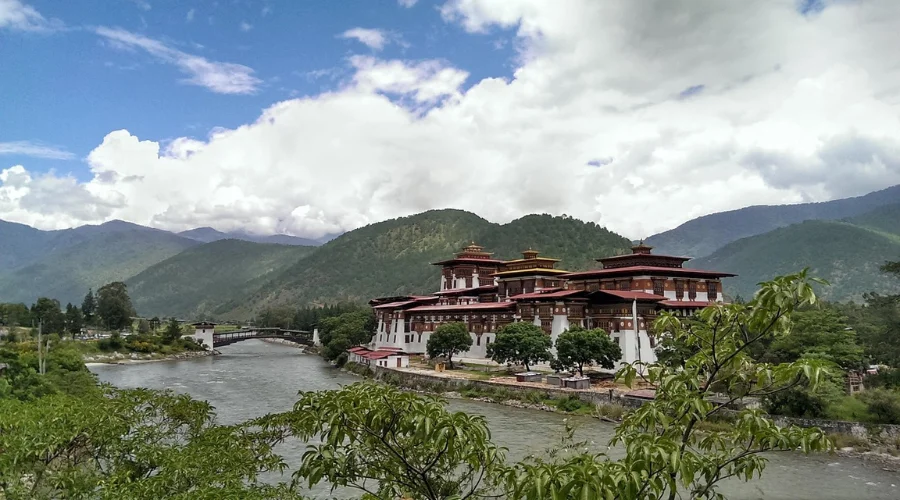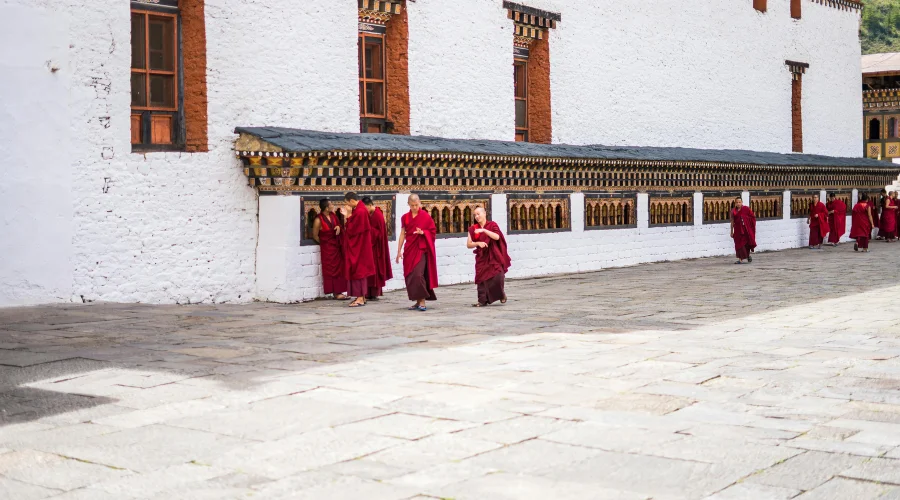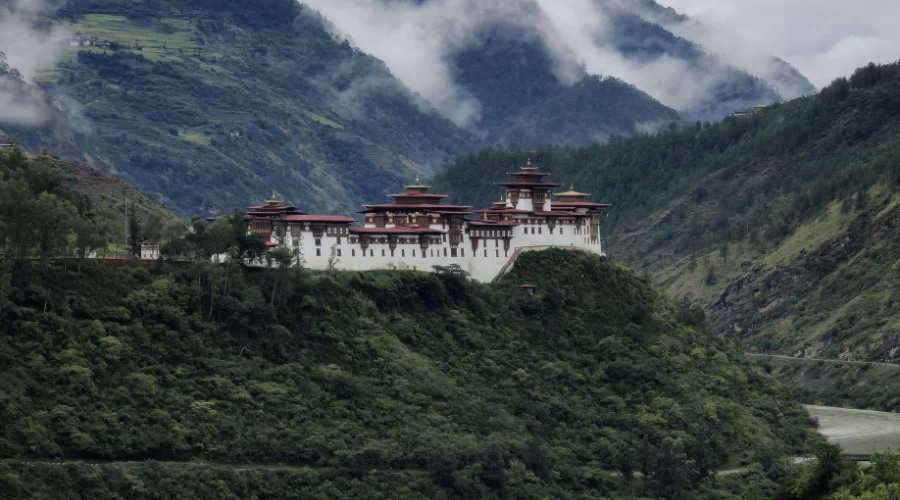Punakha is a must on the list of any trip to Bhutan. It’s among those places that are serene, breathtaking, and full of stories of the past.
Punakha was once the capital of Bhutan until Thimphu took over but even to date, it is deeply rooted in the heart of the country.
The thing which makes Punakha special is its peacefulness and warm weather. Unlike relatively colder areas elsewhere in Bhutan, the place is pleasant most of the time and therefore, exploring here is much nicer and easier.
The green hills surround the valley and as well, bright rice fields and two pretty rivers are found within the valley. Honestly, it resembles a post card directly.
The great attraction at this place is the famous Punakha Dzong. It’s a beautiful ancient fortress erected exactly at the place where two rivers meet.
The “Palace of Great Happiness” is the name the locals give it and when you visit and see it yourself, you’ll certainly know why! It’s not only a beautiful building but a big part of Bhutan’s history and Christ based life.
Although the capital has shifted to Thimphu, Punakha is still the place where the country’s greatest monks stay during winter. That alone proves that it is still very important.
Perhaps the reason many people visit Punakha as part of their trip around Bhutan is that it is the kind of place that ensures that you leave with it on your heart even long after you leave it.
If you want a Nepal Bhutan Tour we can customize it for you.
Why Visit Punakha?
A few of the places around the world where such wonderful combination of history, culture, nature and peace is offered to an average person; Punakha is one of them. It is neither too crowded, nor too modern, and not boring, either.
Punakha – if you are an adventurer eager to explore ancient sites or simple lounging by a riverside with a mountain view, Punakha has it all.
This town is a story book for culture buff. Whether it is old monasteries or sacred temples; Punakha is giving you an opportunity to explore Bhutan’s rich spiritual heritage.
You will see locals dressed in the traditional clothes and involved in religious ceremonies as well as living life just as it used to be for generations.
The festivals which are held here, particularly the Punakha Tshechu are so colorful, musical, and traditional it’s something you don’t want to miss.
The beauty of nature is another cause of love for Punakha. The valley is flooded with green fields, steep hills, calm rivers, and lovely villages.

There are also wonderful short hikes, exquisite river rafting events, and even exciting long suspension bridges to make your trip filled with excitement, though not too overpowering.
And, of course, there is the history. Punakha dzong one of the most significant historical buildings of Bhutan being an eyewitness to many of the significant events. From the royal weddings to the sacred moments, the place has seen everything.
So, why visit Punakha? It is because Bhutan’s past and present reside beautifully in that place. It is an uneventful departure, cultural exploration, and nature getaway in one.
Best Places to Visit in Punakha
At first, Punakha could seem to be a small town, but it is filled with beauty, culture, and charm. If history, nature, or simply quiet places are the kind of your things, here are some Best Places to Visit in Punakha you should not miss.
If you short on days, we even organize Short Bhutan Tour which will be the best for you.
Punakha Dzong
Punakha Dzong also referred to as the palace of great happiness is located at the confluence of two rivers Pho Chhu (male river) and Mo Chhu (female river).
At about 1.2km above sea level, the weather in this place is good in all seasons. This dzong is an old and most attractive fortress in Bhutan built in 1637 by Zhabdrung Ngawang Namgyal.
Previously, it was the capital of Bhutan; it is still rich in spiritual and political significance. The wonderful architecture, the serene ambience and historical significance chiefly attract people in Punakha Dzong.
It is surrounded by bloomed jacaranda in spring. which brings additional appeal. Inside the visitor can discover beautiful murals, golden statues and sacred relics.
The Dzong also helps carry out some important ceremonies, such as the royal wedding of the King and Queen of Bhutan.
When it comes to a vivacious history, spiritual atmosphere, and gentle riverside locale, it is not surprising at all that this is one of Bhutan’s most photographed and respected landmarks.
Chimi Lhakhang
Chimi Lhakhang, or the Temple of Fertility, is one of the best places to visit in Punakha. It is ocated in a small village of Lobesa, which lays right beside the main road, just a few steps from it.
It is about 1, 300 feet from sea level and is surrounded by rice paddies and swaying hills.
The temple was built in the l 15th century by the devotees of Lama Drukpa Kunley, a legendary Buddhist Guru who was well renowned for his unconventional and comic teachings. He is called the Divine Madman out of affection.
This temple is very popular among couples who wish to be blessed with children because it is believed that this place will make them fertile.
The tourists walk through beautiful fields and a peaceful village to the temple; This is the attraction of the experience.
The temple itself is tiny indeed but cosy enough and filled with amazing artwork and symbols, representing the bold personality of the Divine Madman.
Chimi Lhakhang is beloved among people because it offers a fun, creaturely environment and the feel of a home that truly no other Bhutanese temple can match.
Pho Chhu Suspension Bridge
Pho Chhu Suspension bridge is located close to Punakha Dzong and spans the turbulent waters of the Pho Chhu river.
This suspension bridge is one of the longest in Bhutan, which is approximately 160 in length. It is covered in colorful prayer flags that wave in the wind making a beautiful view.
The bridge joins the dzong to the neighboring villages, and the walking trails, making it a functional part of the everyday life of the locals.
The tourists adore this place for being peaceful with amazing sights of river and valley, while strolling across the swaying bridge brings a very gentle thrill.
It is a wonderful place for taking photos and quietly reflecting or just enjoying the noise from the river. The natural beauty and light adventure make it one of the best things to do on any visit to Punakha.
Khamsum Yulley Namgyal Chorten
Khamsum Yulley Namgyal Chorten is a magnificent stupa on a hilltop overlooking the Punakha Valley.
It was built by the Queen Mother of Bhutan during the nineties and located approximately 30minutes drive away from Punakha town. Then, one will find a pleasant walk along rice fields and little forests.
The chorten itself is approximately 30 meters high but brightly and carefully designed Buddhist statues are embedded at each level within it. It was constructed to advance peace and security of Bhutan and the world.

Visitors enjoy visiting here because they value the religious aspect and the journey as well. The short hike is beautiful, soothing, and the views from the top are just amazing.
In terms of the stupa’s ambiance the place is calm and meditative and a jack of all and master of none would be able to find the place particularly captivating as they try to connect themselves with and surroundings setting and the side of self that cherishes spirituality.
Sangchhen Dorji Lhuendrup Nunnery
Sangchhen Dorji Lhuendrup Nunnery is situated on a tranquil ridge that takes in the Punakha and Wangdue valleys. It is elevated and provides cool fresh air as well as a wide view.
This nunnery accommodates many young Buddhist nuns who reside, learn and meditate here. The complex is peaceful and well kept: the main attraction is a large bronze statue of Avalokiteshvara (Chenrezig), Bodhisattva of Compassion, at the heart of the complex.
This place is loved by visitors due to its serene and quiet surroundings. It is not as horde as other places of recreation, and here you can watch the tranquil everyday life of the nuns.
In the gardens it is a perfect place to sit and think as you listen to the peaceful sounds while you enjoy the nice view. The nunnery also offers beautiful sunset views and a magical way to end the day.
Talo Village
Talo Village is situated at nearly 2,800 meters altitude, high up from Punakha, and this results in cooler temperatures and fresh mountain air.
The village is tidy, it has flower gardens, and the residents are friendly. This is where the Queen Mother is said to be from originally and it is culturally significant in Bhutan.
The Talo is well-known for yearly Talo Festival where they show traditional music, dance, and rituals. The village is nicely laid out, houses, small monasteries, and clean stones paths are painted white.
People enjoy going to Talo since this place has a feel of rural Bhutanese life. The villagers are friendly, the surroundings are tranquil, and pretty.
The walk through Talo is like taking a trip back in time, making it the perfect place for cultural photography as well as to learn about Bhutanese traditions.
Rinchengang Village
Rinchengang village is not far from Punakha across the river from Wangdue Phodrang Dzong. It is a tiny historic village which has not changed much since centuries.
The houses here are crowded and follow a unique structure of build in using mud and brick, boasting old Bhutanese architecture. This village has a sense of community with narrow lanes and tight homes.
Rinchengang is charming and quiet and that is what travelers love about it. It is the place where you can enjoy slow exploration and cultural immersion. Unlike other places that are extremely popular to tourists, Rinchengang provides a really and utterly raw experience.
It’s particularly beloved by photographers, lovers of culture, and those who enjoy a peaceful walk amongst Bhutanese heritage.
Best Time to Visit Punakha
The best time to visit Punakha as a tourist is during the spring season (from March through May) and the autumn season (from September to November).
And spring is the Valley alive with beautiful flowers, all the country of a famous Jacarandas trees blooming around Punakha Dzong, the whole area is beginning to become magical in the true sense of this word.
The climate is good, nice enough to allow one to sightsee, hike and river raft. Autumn is portrayed by good weather in terms of clear skies, slightly warm, and incredible view of the Himalayas.
These months are appropriate for trekking, temples and indigenous festivals like Punakha Tshechu. Even though it can be cold during winter (December-February) (especially in the morning and evening hours) it is an excellent opportunity to be in quiet spots and enjoy the tranquility of the season.
Summer (June to August) is the monsoon season, hence not sticking to this time will not interest you if you dislike rain as the trails might be gloomy and the rivers fickle.
Things to Do in Punakha Besides Sightseeing
Besides Sightseeing, you can do so many things which we have listed below:
Try River Rafting on the Mo Chhu and Pho Chhu Rivers
If you are in search of some action and excitement, then river rafting at Punakha is our top recommendation. The rivers here are not overly wild and it is perfect even for beginners.
Rafting allows you to experience the beautiful valley views, pass under Punakha Dzong and feel the cool water splashing as you float in the river. It’s a peaceful but exciting experience; it gives a touch of different flavor to your Punakha trip.
Walk through the rice fields in Lobesa
The rice fields surrounding Lobesa village are the perfect destination for a slow pace relaxing walk. You will go past green terraced fields, small streams and traditional Bhutanese homes.
It is a pleasant sight to view the countryside and immerse in nature. Strolling here, in the morning or at sunset, one experiences tranquillity and refreshing.
Attend a Local Festival
If you happen to visit Punakha during festive season you can take part in its colorful festivities. The most famous one is the Punakha Tshechu and Drubchen.
There will be some monks doing masked dances while others wear beautiful traditional clothes, and peoples will be observing rituals that have been part of their culture for centuries.
It’s a wonderful way to experience the vibes of the place and understand the traditions of the place.
Relax in a Traditional Hot Stone Bath
For a country-house mood after a day of exploring, indulge in a hot stone bath. The bath is done with water that has been heated by fire warmed river stones and combined with curative herbs.
It relaxes your muscles and soothes your mind. This mellow experience is loved by numerous travelers especially during the cooler seasons.
Experience Local Markets and Sample Bhutanese Food.
Throbbing through small Punakha markets you get a taste of normal local life. You can purchase handmade products, taste seasonal fruits or try the Bhutanese snacks such as momo or ema datshi.
Don’t forget to come to a family-run eatery or farmhouse and taste home-cooked meals. The flavors are plain, fresh, and authentic Bhutanese.
How to Reach Punakha?
You can reach punakha from one of the major cities in Bhutan (Thimphu/Paro). Approximately a 3 hour ride from Thimphu which is capital.
The road journey will take you through beautiful valleys, rivers and mountains on a nice scenery. You may hire a taxi, rent a car or book a local conveyance.
If you are coming from Paro, it is slightly longer and takes you 4 to 5 hours by car. The journey along this drive is also beautiful as it runs through the legendary Dochula Pass where you can pull over and admire all the Himalayas in glorious panorama.

For those arriving into the Paro International airport, it’s the bank’s main international gateway to Bhutan. Then when you get there you can hire or arrange a taxi to take you to Punakha.
There are also local buses, but they might take more time and are not as frequent as cabs and private transport around.
However, trips to Punakha through Bhutan are an adventure because the roads wind through lush hills.
Travel Tips for Visiting Punakha
We have made a list of following things that one should know before travelling to Punakha:
- Avoid causing cultural minefields and say hello with a smile.
- Dress modestly, shoulder and knee covered when entering a temple.
- Always ask for permission to take photographs, especially inside temples.
- Be ready to pay tiny entry fees for temples and monasteries.
- Your right hand should be used for giving or receiving gifts and money.
- Respect and silence while the monks are conducting rituals.
- Take local food or drink offered to you (in moderation).
- Be prepared to use cash as there may not be ATMs in remote places.
- Do not show public acts of affection in public places.
- Be prepared for varying weather; carry layers for comfort.
Send an Enquiry
Error: Contact form not found.
© 2025 - Himalayan Trekking and Tours (P) Ltd. All Rights Reserved.

